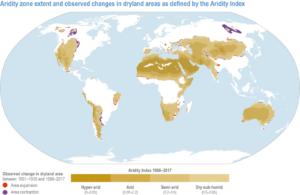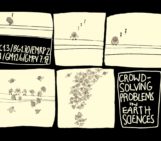
Ever wondered how fast our planet is losing its footing? Imagine this: every time you blink, four football fields’ worth of fertile soil vanish into thin air. According to the UN, that’s a mind-boggling 100 million hectares gobbled up by land degradation each year! But when this happens in dry regions, it morphs into something even more sinister: desertification. Karina Lima, a climate scientist, explains below the gritty details of this silent but colossal threat to our planet’s health and resilience.
Have you heard about the Aral Sea crisis? Located in Central Asia, between the southern part of Kazakhstan and northern Uzbekistan, the Aral oasis used to be the world’s fourth largest saline lake up until the third quarter of the 20th century. Today, the Aral Sea has shrunk to just 10% of its original water surface area, with the remaining land now forming the Aralkum Desert, the world’s newest desert. This change has resulted in frequent sand and dust storms, causing significant environmental pollution and affecting the health of nearby communities. This is just one example of desertification, which is the degradation of land in dry regions. This phenomenon affects even oases, which are typically sanctuaries in the desert.
What constitutes desertification? Is it limited to deserts?
Thirty years ago, the United Nations Convention to Combat Desertification (UNCCD) was established and defined “desertification” as land degradation in arid, semi-arid, and dry sub-humid areas – which are known as “drylands”. Therefore, even though it is intuitive to associate desertification with the expansion of deserts, in fact, the term encompasses all forms of degradation that occur in drylands, which in other definitions, may also include hyper-arid regions, thus covering almost half of the Earth’s surface.

Figure CCP3.1 | Aridity zone extent and observed changes in dryland areas as defined by the Aridity Index (AI).
What causes desertification?
Desertification is driven by a mix of factors, including natural climate variations and human activities such as unsustainable land use and climate change caused by human actions. These elements work together and over time, result in a degraded land, less fertile or even infertile soils, and reduced vegetation cover.
Desertification is driven by human activities such as urban sprawl, mining for minerals, the proliferation of livestock, inappropriate forms of land use and escalating levels of resource consumption. Natural landscapes are turned into areas covered with concrete which does not allow water to penetrate through and support vegetation. This makes them expand at rates that far exceed those in normal conditions, thereby causing desertification. Mining removes top soil leaving behind bare lands which are prone to erosions.
Overgrazing by livestock depletes vegetation cover, resulting in soil erosion by wind and water, while improper management practices lead to the loss of essential nutrients needed to maintain soil fertility. Another driver is deforestation, which occurs due to the insatiable demand for resources, leading to the clearance of forests that hold soils together and regulate water cycles. In addition to this, agricultural expansion involves clearing land, which is often followed by soil degradation.
But human influence goes further, as anthropogenic climate change has impacted some drylands by raising temperatures, increasing evapotranspiration, and altering rainfall patterns. Higher temperatures increase vegetation stress and soil evaporation. Changes in the hydrological cycle, leading to a gradual shift to drier climatic conditions (aridification), enhance the process of desertification. With reduced rainfall, water supply becomes deficient relative to the evapotranspirative demand of vegetation and soil. In a self-reinforcing cycle between land and atmosphere, the absence of sufficient water supply results in fewer plants. As a result, less moisture is added to the atmosphere, which intensifies aridity and further dries out the soil.
Also, with every additional increment of global warming, the frequency and intensity of extreme events increases, which can be related to hot temperature extremes over land, heavy precipitation, and droughts in drying regions – droughts that are already more likely and extreme in the current context and tend to worsen as long as global warming is not stabilized. Additionally, degraded soils have a reduced water retention capacity and are more susceptible to erosion, which can be intensified by extreme rainfall events when they occur.
Climate change can drive desertification, which in turn can also provide feedbacks on local and global climate, contributing to further global warming. This happens because the process of land degradation can produce greenhouse gas emissions – through deforestation, overgrazing, etc. Moreover, degraded soil inhibits plant growth and has less capacity to sequester carbon from the atmosphere.
Desertification also poses a serious threat to food security and the livelihoods of about 3 billion people living in drylands. And the related impacts are not necessarily confined to these regions, as socioeconomic aspects can trigger conflicts, migrations, and several far-reaching implications.
Most drylands are located in Asia and Africa, but these sensitive ecosystems are present on all continents. It is estimated that the European Union already has about 8% of its territory affected by desertification in countries such as Greece, Spain, Bulgaria, Cyprus, Portugal, Italy, and others.
A report by the Ministry of Science, Technology, and Innovations in Brazil states there is a trend of increasing aridity across almost the entire country, mainly due to increased evaporation associated with rising temperatures caused by global warming. There has been a constant expansion of semi-arid areas for several decades, and recently, there has also been an expansion of dry sub-humid areas and the identification of arid areas for the first time. A context that suggests an acceleration of the process.
So, are our oases at threat?
Oases are critically important in arid and hyper-arid regions. They provide essential water and support life for both humans and other species. Currently found in 37 countries, they are often the only means enabling agricultural production in their regions thanks to their reliable water supply, which can originate from aquifers, rivers, and mountain snowmelt.
The global impact of climate change is increasingly affecting oases worldwide. Projections for the coming decades indicate significant changes in thermal and hydrological cycles that will particularly impact oases in countries like Tunisia, Morocco, and Saudi Arabia. But it’s not just the future that is concerning, there is already evidence of desertification of oases in China, Mexico, Mesopotamian Arabian desert, and the Indian subcontinent.
A new study published in the AGU journal Earth’s Future analyzed the growth of oasis areas on a global scale and concluded that most of it was due to artificial expansion projects in an unsustainable manner, while in the opposite direction, there was loss of large oasis areas due to desertification. Water is the key factor, and if the resource is overexploited to the point of exceeding its regeneration capacity or becomes less available due to climate change, the oasis may undergo desertification and be extinct. The pressure on oases is increasing in the current global warming scenario. It is heightening risks as demand for water resources rises and climate-induced scarcity and desertification amplify threats. The study also proposes strategies to enhance water resource management for achieving long-term sustainable development of oases amidst ongoing climate challenges.
Desertification, as well as land degradation and droughts, are considered major and urgent challenges of our time and are included among the 17 goals of the 2030 Agenda for Sustainable Development. Sustainable Development Goal 15 aims to “protect, restore and promote sustainable use of terrestrial ecosystems, sustainably manage forests, combat desertification, and halt and reverse land degradation and halt biodiversity loss“
The coming years are critical in addressing the climate change crisis and other significant environmental challenges such as desertification. These issues have arisen due to an unsustainable development model that has long viewed the Earth as an infinite provider of resources. However, by adhering to science and taking immediate action, the future can still be altered in order to make it possible for us, and for the generations to come, to survive on this planet.
The choices we make today are defining our future on Earth, the common home we share with all other species that inhabit it.
References:
Cui, B. et al., 2024. Distribution and growth drivers of oases at a global scale. Earth’s Future, 12, e2023EF004086. doi: 10.1029/2023EF004086.
IPCC, 2019. Climate Change and Land: an IPCC special report on climate change, desertification, land degradation, sustainable land management, food security, and greenhouse gas fluxes in terrestrial ecosystems. In press.
Mirzabaev, A. et al., 2022. Cross-Chapter Paper 3: Deserts, Semiarid Areas and Desertification. In: Climate Change 2022: Impacts, Adaptation and Vulnerability. Cambridge University Press, pp. 2195–2231. doi: 10.1017/9781009325844.020.
Seneviratne, S.I. et al., 2021. Weather and Climate Extreme Events in a Changing Climate. In Climate Change 2021: The Physical Science Basis. Cambridge University Press, pp. 1513–1766. doi: 10.1017/9781009157896.013.
Images:
Figure CCP3.1 : https://www.ipcc.ch/report/ar6/wg2/figures/chapter-ccp3/figure-ccp3-001
FIGURE 3.15B: https://www.ipcc.ch/srccl/chapter/chapter-3/





